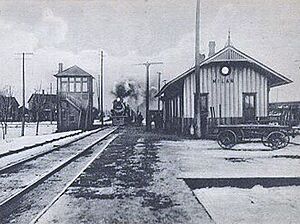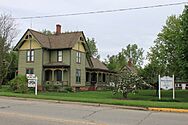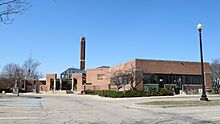Milan, Michigan facts for kids
Quick facts for kids
Milan, Michigan
|
|
|---|---|
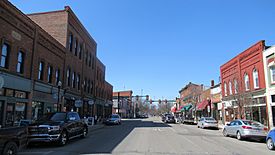
Looking east along Main Street
|
|
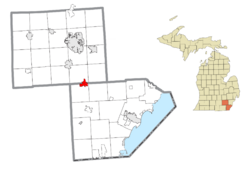
Left: location within Monroe County (bottom) and Washtenaw County (top); Right: location within the state of Michigan
|
|
| Country | United States |
| State | Michigan |
| Counties | Monroe and Washtenaw |
| Settled | 1831 |
| Incorporated | 1885 (village) 1967 (city) |
| Government | |
| • Type | Mayor–council |
| Area | |
| • Total | 3.56 sq mi (9.2 km2) |
| • Land | 3.48 sq mi (9.0 km2) |
| • Water | 0.08 sq mi (0.2 km2) |
| Elevation | 702 ft (214 m) |
| Population
(2020)
|
|
| • Total | 6,079 |
| • Density | 1,747.8/sq mi (674.8/km2) |
| Time zone | UTC-5 (Eastern (EST)) |
| • Summer (DST) | UTC-4 (EDT) |
| ZIP Code |
48160
|
| Area code(s) | 734 |
| FIPS code | 26-53920 |
| GNIS feature ID | 632302 |
Milan (pronounced MY-lin or MY-lən) is a city in the state of Michigan, USA. It is located in both Monroe and Washtenaw counties. In 2020, about 6,079 people lived there.
The area where Milan is now was first settled in 1831. Milan officially became a village in 1885. Later, in 1967, it became a city. The central part of downtown Milan is a special historic area. It is called the Main Street Historic District. This district is listed on the National Register of Historic Places.
Contents
History of Milan
The first person to settle in this area was John Marvin. He arrived in the spring of 1831. He named the community "Tolanville" after his brother-in-law, Henry Tolan. Today, a part of downtown Milan is called Tolan Square. John Marvin built his home and also ran a general store. This store served travelers and other early residents.
Other early settlers included Bethuel Hack and Harmon Allen. Their families were among the first people to live there permanently. The number of people living in the area started to grow. The first post office opened on March 27, 1833. It was first called "Farmersville." The name changed to Milan on April 21, 1836. The post office has been open ever since. It is currently located at 123 East Main Street.
Milan became part of York Township in Washtenaw County in 1833. It also became part of Milan Township in Monroe County in 1836. Other nearby communities were Azalia, Cone, and Mooreville.
Some of Milan's oldest buildings are still standing today. The Community House was built in 1834. It was first used as a gristmill, which grinds grain. Henry Ford bought it in 1935. He used it to process soybeans for car paint. Now, it is used as a place for events.
The Hack House Museum was built in 1888. It was a private home for many years. Now, the Milan Area Historic Society uses it. One of the most famous buildings is the Old Milan Fire Barn. It was built in 1897. It was a fire station until 1979. The fire department moved out, and the building was empty. In 1983, it was given to the Milan Area Historical Society. The building was fixed up and reopened in 2002.
In the 1870s, a railway line was built through Milan. The Wabash Railroad operated this line. Later, it connected with the Ann Arbor Railroad. Trains still pass through the area. However, there is no longer a train station in Milan.
Geography of Milan
Milan is located in the northwest part of Monroe County. It is also in the southern part of Washtenaw County. The city's borders are almost equally split between the two counties. However, the downtown area and most of the older buildings are in Washtenaw County.
Milan is about 16 miles (26 km) south of Ann Arbor. It is also about 21 miles (34 km) northwest of Monroe. Ann Arbor is the county seat for Washtenaw County. Monroe is the county seat for Monroe County.
According to the U.S. Census Bureau, Milan covers a total area of 3.56 square miles (9.22 km2). Most of this area, 3.48 square miles (9.01 km2), is land. The remaining 0.08 square miles (0.21 km2) is water.
The Saline River flows through the middle of Milan. This river flows southeast into the River Raisin. The River Raisin is part of the Lake Erie watershed. This means its water eventually flows into Lake Erie.
The city of Milan uses the 48160 ZIP Code. This ZIP Code also covers a larger area. This includes London Township and Milan Township in Monroe County. It also covers Augusta Charter Township and York Charter Township in Washtenaw County.
Major Roads in Milan
 US 23 is a four-lane highway. It runs north and south along the eastern edge of the city.
US 23 is a four-lane highway. It runs north and south along the eastern edge of the city.
Population Information
| Historical population | |||
|---|---|---|---|
| Census | Pop. | %± | |
| 1880 | 320 | — | |
| 1890 | 917 | 186.6% | |
| 1900 | 1,141 | 24.4% | |
| 1910 | 1,355 | 18.8% | |
| 1920 | 1,557 | 14.9% | |
| 1930 | 1,947 | 25.0% | |
| 1940 | 2,340 | 20.2% | |
| 1950 | 2,768 | 18.3% | |
| 1960 | 3,616 | 30.6% | |
| 1970 | 3,997 | 10.5% | |
| 1980 | 4,182 | 4.6% | |
| 1990 | 4,040 | −3.4% | |
| 2000 | 4,775 | 18.2% | |
| 2010 | 5,836 | 22.2% | |
| 2020 | 6,079 | 4.2% | |
| U.S. Decennial Census | |||
As of the 2010 census, there were 5,836 people living in Milan. There were 2,308 households, which are groups of people living together. About 38.5% of these households had children under 18 years old. The average age of people in the city was 34.4 years. About 28% of residents were under 18 years old.
Education in Milan
The city of Milan is served by Milan Area Schools. This school district also includes parts of nearby townships. These townships are in both Monroe County and Washtenaw County. All the schools in the district are located within Milan city limits. This includes Milan High School.
Notable People from Milan
- Denise Nicholas is a film and television actress. She starred in the TV series Room 222. She was born in Detroit but grew up in Milan.
- Stan Joplin was a basketball player and coach. He was the head men's basketball coach at the University of Toledo.
Images for kids
-
The Hack House, built in 1888
See also
 In Spanish: Milan (Míchigan) para niños
In Spanish: Milan (Míchigan) para niños




